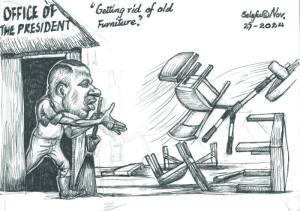Quill Hermans, the architect behind the Pula currency, passed away recently. This week, leaders of the financial services gathered to remember him, his diligence and integrity, while sharing anecdotes such as how some Batswana initially wanted the Pula to be named “motokwane”. MBONGENI MGUNI writes
Former Bank of Botswana governor, Moses Pelaelo, remembers Quill Hermans’ steadfast integrity.
“In Quill Hermans’ central bank, if you stole a bar of soap from the bathroom, you are gone.
“You cannot be in the central bank and steal.
“He believed in integrity and in his mind, in the frontline, ethics was number one.”
Hermans, the first governor of the Bank of Botswana (BoB), passed away on October 28 and on Tuesday, dozens of past and present leaders in the financial sector, as well as former President Mokgweetsi Masisi, attended his memorial in Gaborone.
As the grey skies deepened in intensity and eventually burst into rain in the late afternoon at a garden located near Gaborone Dam, speaker after speaker lauded the late pathfinder who is most notably the architect of the Pula and the driving force behind the BoB’s establishment.
Born in Cape Town on December 23, 1936, Hermans went from his grandfather’s cattle ranch in the Northern Cape to being employed as a senior finance officer in the Bechuanaland Protectorate administration, then based in Mahikeng.
According to a biography compiled by Jeff Ramsay, in 1965 Hermans opted to take up citizenship in the then self-governing territory, joining its small cadre of permanent and pensionable civil servants. Ramsay says shortly after independence, Hermans was awarded a United Nations fellowship at Vanderbilt University in the USA, where he completed a Master’s Degree in Development Economic and on his return, he became the Ministry of Finance and Development Planning permanent secretary, working under founding minister, Sir Ketumile Masire, who was also Vice President.
From Independence, Botswana was part of the Rand Monetary Area (RMA) which included Lesotho and Swaziland using the South African Rand as legal currency. However, according to Hermans’ own written account, in 1973, anticipating that negotiations for a new RMA agreement that was more favourable to the smaller members would be problematic, Sir Seretse Khama appointed a Monetary Preparatory Commission. The commission, chaired by Hermans, led Botswana to withdraw from the RMA and later establish both the Pula and the Bank of Botswana.
The country’s own monetary system was established and the diamond revenues which had begun to flow from the mines in the early 1970s, were banked on home soil in local currency, building up a domestic treasury and later, developing today’s well-established financial sector, and the broader economy.
Pelaelo noted that Hermans intimately understood the relationship between personal integrity and the integrity of the institution of the BoB.
“We need to know that the products that we have like currency and others are pieces of paper.
“However, with the signature of the governor, they become a liability of the State and you cannot do that without integrity.
“When it comes to corruption, I can say not in the central bank and that’s Hermans’ legacy,” he said.
Recalling Hermans’ role in the establishment of the Pula, Pelaelo said the late governor was at the centre of the achievement.
“The first name they thought was going to be adopted for the currency was motokwane because many Batswana suggested that this should be the name,” Pelaelo said.
“I’m not sure why.
“Later we had Bank of England staff coming into help and Hermans led that.
“He later went away with the World Bank and came back in 1987 to make tremendous contributions to build the institution to what it is today.
“Some of us for whatever reason could get called to the governor’s residence and you will be sitting around a table and he would put up a topic and we would discuss with open minds.
“That’s how he built us.”
For his part, Masisi recalled the fatherly neighbourhood role Hermans played in the 1960s when the late governor’s family moved in next to the former president’s family in Gaborone.
“Hermans was a tough teacher and tried to teach us children after work,” Masisi said.
“He was the perfect public servant who read a lot and paid service a lot, but when he came home, he was the ultimate father.
“He had a lot of time for young curious children who had never seen development.
“I never imagined the full impact of the work he did until I started working myself.
“It’s a pity I didn’t find enough time to spend with Quill later in life and now he has left us.”
Masisi urged Batswana to remember Hermans’ contributions to the country’s economy.
“I want us to memorialise Quill by realising that he and others were the driving force behind the Pula, its stability and the integrity of diamonds.
“What a wonderful job he has done for us,” he said.
Herman’s son, Tim, told the memorial that his father ethos was all about service.
“My father was a man who believed in service.
“At home, his principles also showed. For instance, he built a house for our beloved maid Rosy, in Old Naledi.
“He did the digging of the foundation, installed the windows and doors and everything else with his own hands.
“He was a role model in my life and I have always tried to manifest that service.”
Quill Hermans is survived by his three children and other family members.








